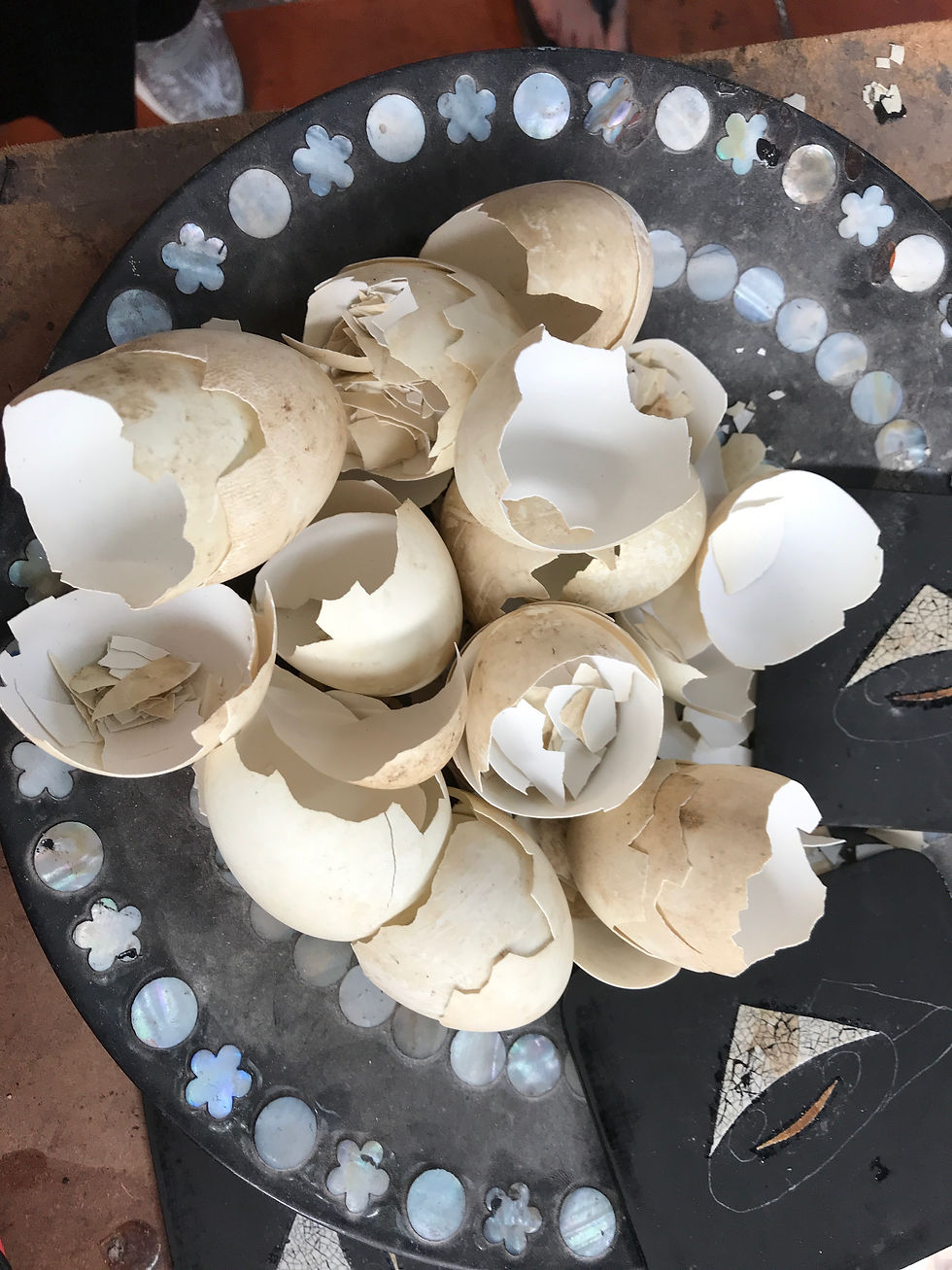Art & Skyscrapers in ‘The Paris of the East’
- Admin
- Mar 23, 2018
- 4 min read

[We visited a lacquerware workshop and showroom. Eggshells, as well as mother of pearl, are used to create white or off-white areas on lacquerware.]
VIET NAM, Day #2:
Since I had been to Saigon two years ago with the Yale Alumni Chorus, I thought I was opting out of a long, long bus ride into the city from our faraway port, but I ended up back in Ho Chi Minh (HCMC) after all. Population: 8.4 million. Population of Viet Nam: 93 million.
The Saigon River Artists’ Village optional excursion that I’d picked turned out to be an enclave of homes and artists’ studios built of wood in a reclaimed mangrove swamp and wasteland just outside the built-up part of the HCMC. The bus seemed to go in circles, weaving in and out of barren land and odd construction sites, trying to locate the place along the Saigon River. I say ‘odd’ because there was a lone backhoe digging a hole under a bridge, with no other workmen or equipment in sight. And five men up to their thighs in a wide water-filled gully along the highway, with no tools. The Artists’ Village was started in the 1990s by a Chinese artist who immigrated to Viet Nam and sought a peaceful, quiet place to work outside the metropolis. The wooden homes are built in the style of the Muong people from North Viet Nam, and set in a barren area that has a few new concrete houses, shown further below.



Nice place to fish from, but I wouldn’t eat what comes out of that pond.

The Saigon skyline was visible from the village.


The founder’s daughter gave us the tour through the studios and galleries exhibiting oil paintings, watercolors, pottery, sculpture, lacquer paintings and what the daughter termed ‘Chinese water ink’ drawings. About 20 artists work there, though only a couple were on hand that day.

The visit ended with a demonstration by this artist. We’d been told he would paint a horse, and we couldn’t find the horse in the first two shots. He explained afterwards that the daughter had handed him a piece of paper that was too small for a horse, so he did a bird on bamboo instead, followed by a horse. As you can imagine, with ‘Chinese water ink,’ there is no room for error:



New homes were under construction outside the artists’ enclave. I assume the lots were cheap, as there is very little building in this neighborhood right outside downtown Saigon. Note the ornamentation on the front and the roof. But why, you may ask, are there no windows on the side? I think I know the answer. Last trip, in 2016, we were told that land in Viet Nam is the sixth most expensive in the world. And since they’re taxed on the amount of frontage, owners who build narrow homes pay less in taxes. This owner must be anticipating that another narrow, blank-sided home will be built right next door.

However, that does not apply to this house. Based on my taxation theory, this owner does not have to worry about expenses!


Next we were driven into Saigon and shown the sights (from the bus). I asked my usual, Who’s behind the funding of all this building? Answer: China... and the U.S.

After a very elegant lunch at ‘The Dining Room’ restaurant, a walk past the French colonial-era Opera House...

...then a little retail therapy on shop-filled Dong Khoi Street. At this one, a Viking beside me said, ‘Oh, how pretty.’ I couldn’t help it: I replied, ‘It’s junk.’ Maybe she thought I was making a joke about Chinese junks. I was actually making a comment on the quality of these ‘ship models.’ I know a good one when I see one, and these ain’t it.

This one’s for Deb...

Just after I had bought a $4 Vietnamese drip coffee gadget from a woman on the street (with samples of terrific local coffee), this lady pedaled by, dispensing coffee on the go to whoever wanted a cup.

Amidst the new buildings, there are still some vestiges of Old Saigon...

Despite the modest businesses and homes along the route, the entire highway from downtown HCMC back to the port where we were docked was landscaped with flowering shrubs and bonsai-ed trees. More narrow houses that go up, and not out.

Tidbits:
As of 2 years ago, Viet Nam was #2 in world coffee exports after Brazil, and #2 in rice exports after Thailand. (I learned later that Thailand is famous for jasmine rice.)
I also got the correct pronunciation of the Pho noodle soup I had enjoyed so often on the last trip: it’s ‘fuh.’
Chinese cooks use fresh lotus flower seeds in duck and chicken dishes, and in desserts.
On the bus radio playing hours of Muzak-y instrumental covers of western music, we heard this well known West Side Story refrain:
‘I like to be in Amerika, Okay by me in Amerika …’
Funny, no? #


Comments